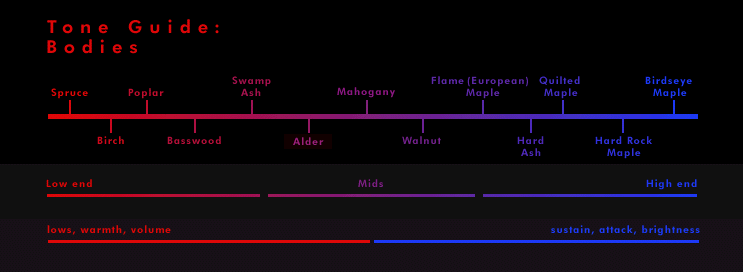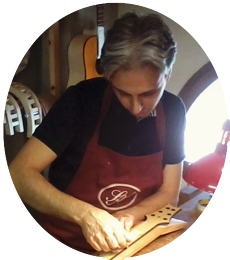
Visit the new website: www.buildyourownguitaronline.com
Visit the new website: www.buildyourownguitaronline.com
HOME > Matching guitar woods
MATCHING GUITAR WOODS
When combining different types of wood (lamination), it is necessary to take into account different factors, such as seasoning, specific density, rigidity, and therefore sound and reactivity to the climatic changes of each wood used.
Tonally each wood has its own resonance peak.
Mixing different woods results in combining the resonance peaks of each wood and obtaining a sound that is the total of the sonorities of the different woods used.
For example, mixing more hardwoods, as is usually done in the laminated necks of neck through instruments, gives the instrument a more uniform sound, which is clearer and more defined on the fundamental harmonic, as well as greater sustain due to the greater rigidity.
Gluing a top or a top plate of hardwood such as maple or bubinga or ebony on a core of medium dense wood such as mahogany or even lighter wood, such as lime American basswood, will ensure you keep the warmth of the core used for the body, whilst gaining more definition in the note, a slightly faster attack and a bit of brilliance and sustain.
Mixing different types of essences substantially renders the string’s vibration more balanced and, by raising the resonance peak of the entire instrument beyond that of the strings, frequently helps to support the sustain and reduce 'dead spots'.
It is here that we can note the big difference between a
neck through
and a bolt on instrument, where the first will be marked by a greater uniformity of sound and sustain, and a greater attack and note definition, while the second will provide a sound that is more typical of the single type of wood used: normally fuller and often characterized by a greater volume and punch.
When combining the various pieces of wood, it is necessary to apply the Frudua exclusive "tapping" technique.
Before gluing, it is always advisable to join the two pieces of wood you are going to glue with clamps for at least 24 hours (especially if they are different woods and not perfectly seasoned). This procedure, called "wood equalization", allows you to stabilize and even out the humidity inside the two parts, benefiting the glue’s durability and the sound.
The ideal gluing of different woods involves sanding the surfaces to be joined with 80 grit sandpaper and not too much clamp pressure.





